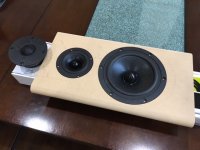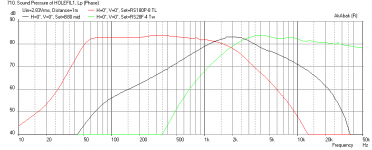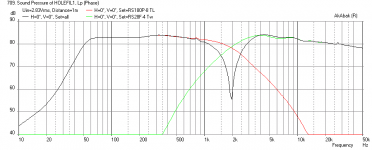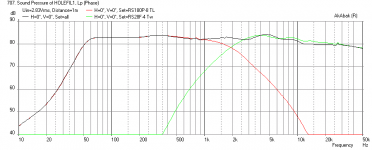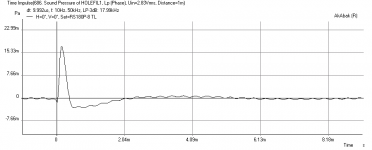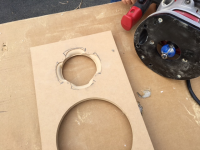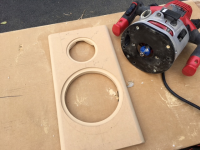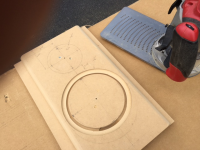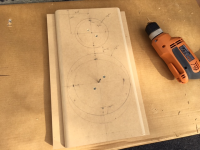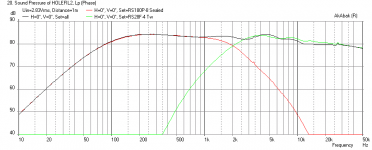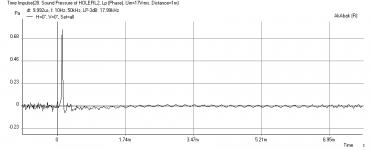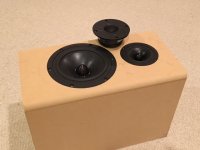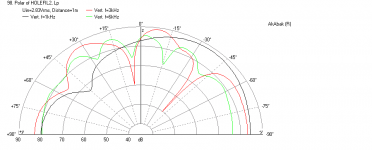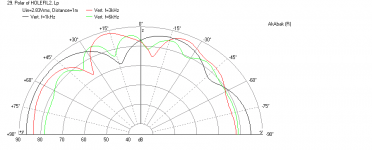I have been planning these for a long time and parts have been collected and ready to build. I finally took the plunge (pun intended) and used a router today to cut the driver cutouts with rebates with a circle jig. That's a lot of work to cut a couple of holes.
The speaker will be my new reference bookshelf (standmount) monitors using Dayton RS28F-4 silk domes and RS180P-8 paper woofer. I will use a second order XO with both drivers in positive absolute phase. A deep notch will result at XO frequency, so I will use the B&O Hole Filler technique to place a wideband midrange at the notch. The mid will be the very capable Visaton B80 with a first order filter on both sides that will perfectly fill in the notch (or hole). With proper offsets and crossover design, a flat phase transient perfect speaker should be possible.
The enclosure consists of a 0.56 cubic ft Denovo flat pack cabinet which will house the woofer and mid. The mid will have a sealed Dagger rear chamber for low coloration. I am still debating whether or not to make the woofer sealed or vented. The tweeter will be placed on a small trapezoidal baffle that sits atop of the main cabinet to allow setback for time alignment.
Sensitivity of system will be dictated by woofer and baffle step. RS180P-8 is spec'd at 89dB. Assuming circa -4dB baffle step loss overall system sensitivity will be 85dB. This matches the B80 almost perfectly and the RS28 will have to be attenuated quite a bit.
Initial simulations show bass extension around 55Hz to 62Hz depending on tuning. Bass won't be this speaker's strong suit but rather detailed mid range and clear resolved highs with excellent transient response will be the goal.
Some pictures of drivers after cutting out holes. Still need to make trapezoidal mount for tweeter. Then make measurements, then develop crossover in PCD or xsim. Lots of work ahead.
What's interesting is that the B80 has the exact same cutout diameter as the RS28. Is there any advantage to a MTW vs a TWM for an application like this?
The MTW gives the cool option of running this as traditional 2 way by flipping polarity of tweeter and not using mid.
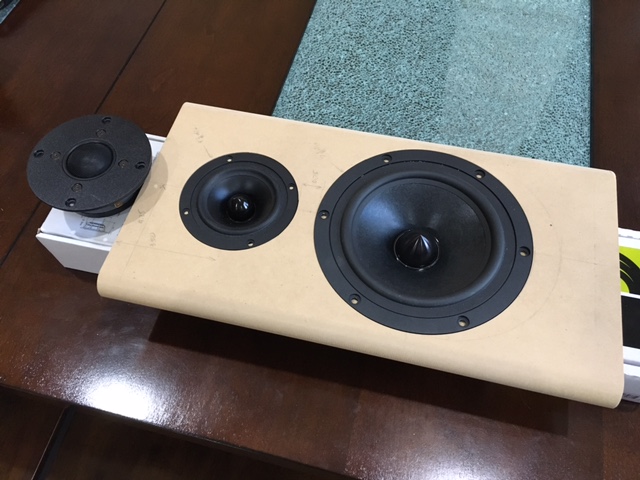
Edit: I am going with tweeter mounted in main box with a waveguide to provide best vertical and horizontal polar response.
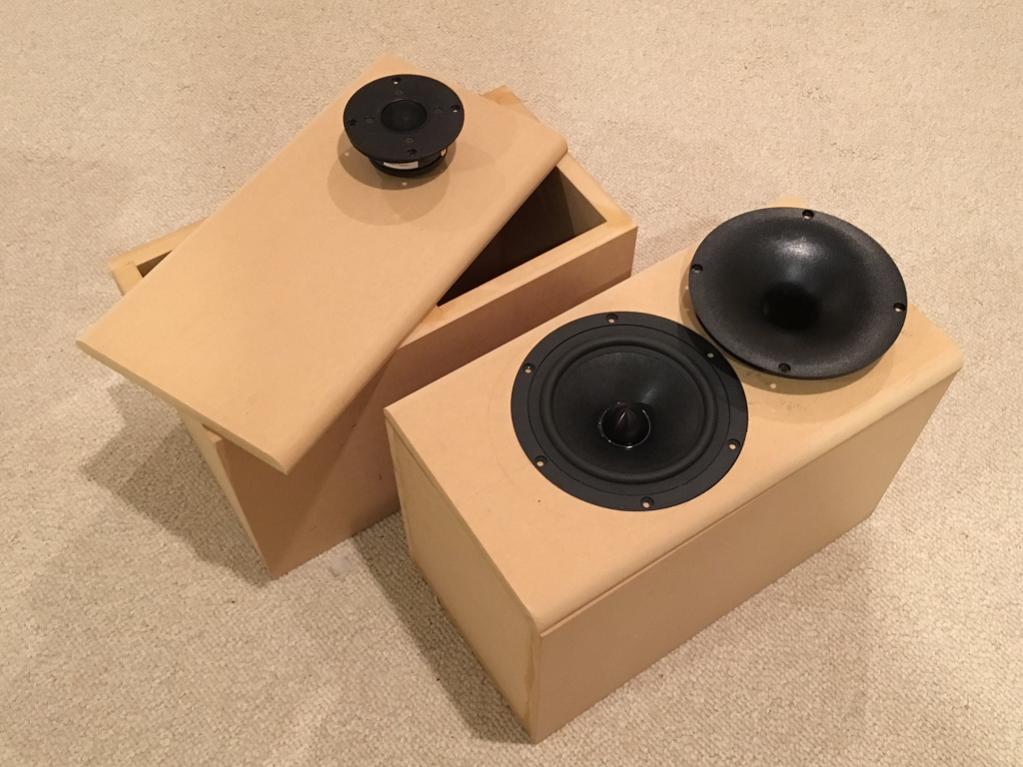
WG-300 fitted to RS28F using 3d printed adapter plate:
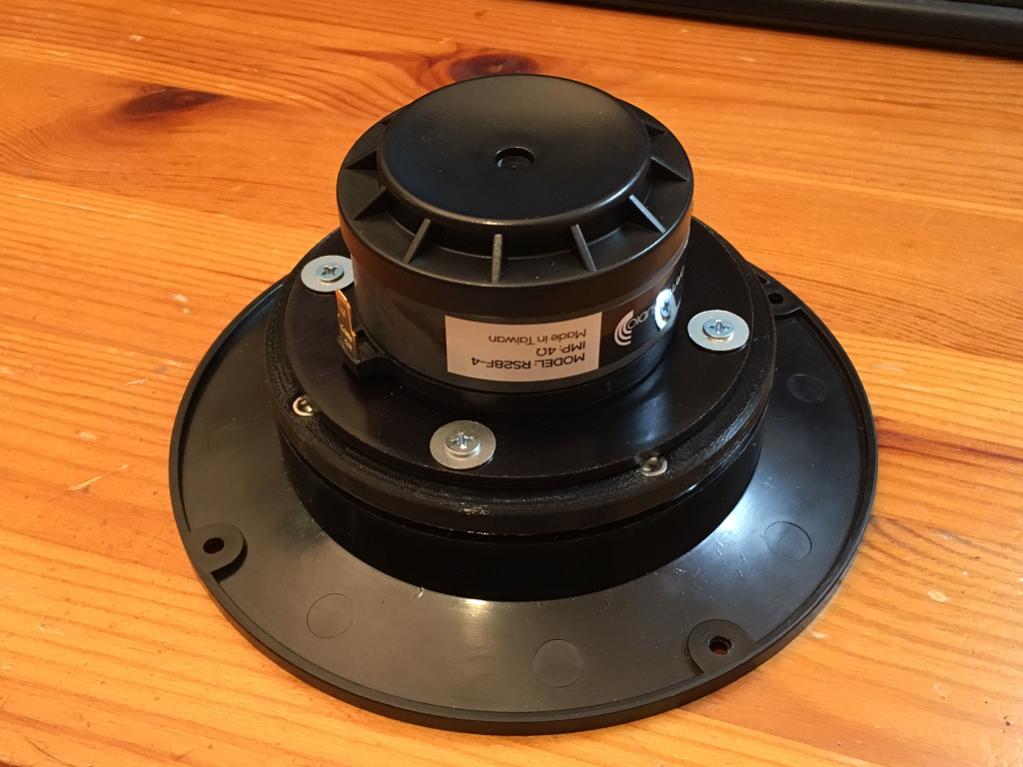

The speaker will be my new reference bookshelf (standmount) monitors using Dayton RS28F-4 silk domes and RS180P-8 paper woofer. I will use a second order XO with both drivers in positive absolute phase. A deep notch will result at XO frequency, so I will use the B&O Hole Filler technique to place a wideband midrange at the notch. The mid will be the very capable Visaton B80 with a first order filter on both sides that will perfectly fill in the notch (or hole). With proper offsets and crossover design, a flat phase transient perfect speaker should be possible.
The enclosure consists of a 0.56 cubic ft Denovo flat pack cabinet which will house the woofer and mid. The mid will have a sealed Dagger rear chamber for low coloration. I am still debating whether or not to make the woofer sealed or vented. The tweeter will be placed on a small trapezoidal baffle that sits atop of the main cabinet to allow setback for time alignment.
Sensitivity of system will be dictated by woofer and baffle step. RS180P-8 is spec'd at 89dB. Assuming circa -4dB baffle step loss overall system sensitivity will be 85dB. This matches the B80 almost perfectly and the RS28 will have to be attenuated quite a bit.
Initial simulations show bass extension around 55Hz to 62Hz depending on tuning. Bass won't be this speaker's strong suit but rather detailed mid range and clear resolved highs with excellent transient response will be the goal.
Some pictures of drivers after cutting out holes. Still need to make trapezoidal mount for tweeter. Then make measurements, then develop crossover in PCD or xsim. Lots of work ahead.
What's interesting is that the B80 has the exact same cutout diameter as the RS28. Is there any advantage to a MTW vs a TWM for an application like this?
The MTW gives the cool option of running this as traditional 2 way by flipping polarity of tweeter and not using mid.

Edit: I am going with tweeter mounted in main box with a waveguide to provide best vertical and horizontal polar response.

WG-300 fitted to RS28F using 3d printed adapter plate:


Attachments
Last edited:
I assume this will be a passive speaker? Personally I'd stay away from ported if one of my goals would be "a flat phase transient perfect speaker" though I understand wanting more bottom end than a sealed speaker might give you passively.
Yet most of the rewards (for me personally) of flat phase have been on the bottom side.
As always there are compromises to choose from. Too bad you're looking at a bookshelf concept. There is so much fun and atmosphere in the bottom end....
Feeling as much as you hear it... But getting that to be transient will be increasingly difficult in a passive design.
I gather this will be an amp test setup?
Yet most of the rewards (for me personally) of flat phase have been on the bottom side.
As always there are compromises to choose from. Too bad you're looking at a bookshelf concept. There is so much fun and atmosphere in the bottom end....
Feeling as much as you hear it... But getting that to be transient will be increasingly difficult in a passive design.
I gather this will be an amp test setup?
I assume this will be a passive speaker? Personally I'd stay away from ported if one of my goals would be "a flat phase transient perfect speaker" though I understand wanting more bottom end than a sealed speaker might give you passively.
Yet most of the rewards (for me personally) of flat phase have been on the bottom side.
As always there are compromises to choose from. Too bad you're looking at a bookshelf concept. There is so much fun and atmosphere in the bottom end....
Feeling as much as you hear it... But getting that to be transient will be increasingly difficult in a passive design.
I gather this will be an amp test setup?
Correct, this is going to be a passive crossover speaker and my first attempt at a multi-way passive using traditional XO measure/sim/build techniques. I may still go sealed if I feel that I can live with the low end as is. It's a passive speaker for testing my amp collection - you got that correct. I am numbering about over a dozen class AB and a couple class A amps in last 6 months and need a good speaker to hear them on. My current passive 10F/RS225 has been doing a good job but I want to hear that top end sparkle only a silk dome can provide. The B80 and RS180P are both paper cone so the tone and voicing should be similar.
Hole Filler rough sims
These are very rough sims in Akabak to show the hole filler concept. The model of the RS28F is approximate as I had to estimate the rear chamber and dome curvature etc. RS180P and B80 T/S params are from manufacturer specs. I guess I should use my own measured ones from DATS but this is something I whipped up on my commute to work this morning.
Here is response of drivers alone with a 1.9kHz XO point. Sims are showing baffle step losses greater than I anticipated - in 4pi space sensitivity is only 83dB. You can see how important the mid range hole filler driver is - it has to work over a very wide range to fill in what appears to be a very notch. Not too many drivers are capable of a linear wide bandwidth like this:
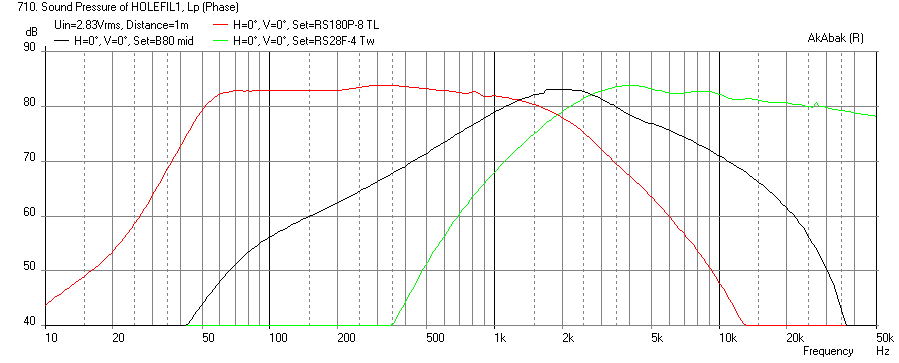
Here is what it looks like with no B80 mid showing the deep "hole" that forms when you have two second order filters in phase (both +ve absolute phase):
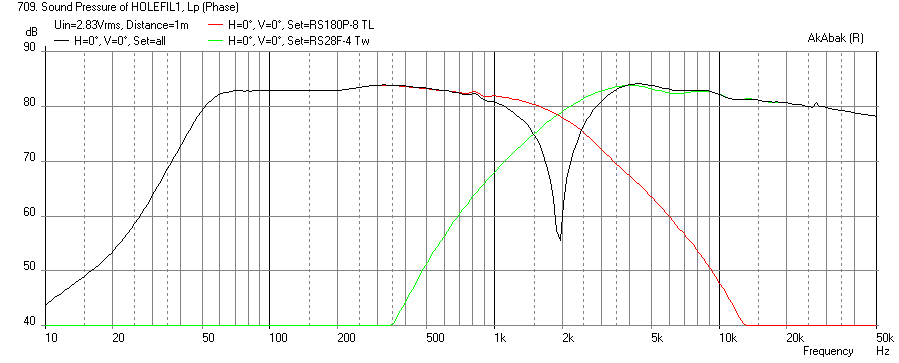
Now if we turn on the B80 (I still need to fine tune phase and maybe add a notch filter or two), you get this - the B&O Hole Filler XO:
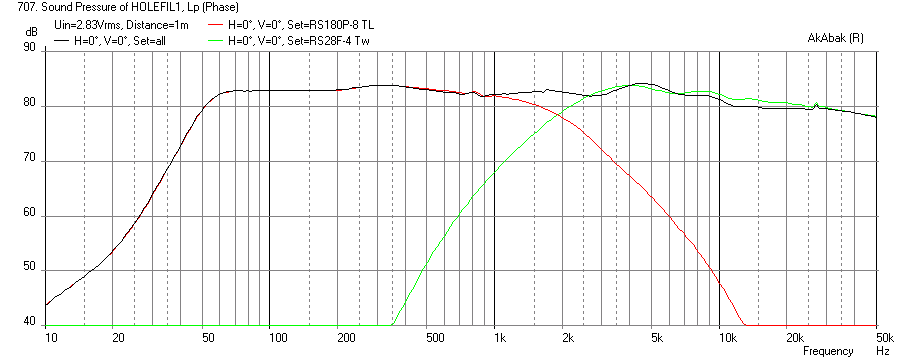
Here is the impulse response:
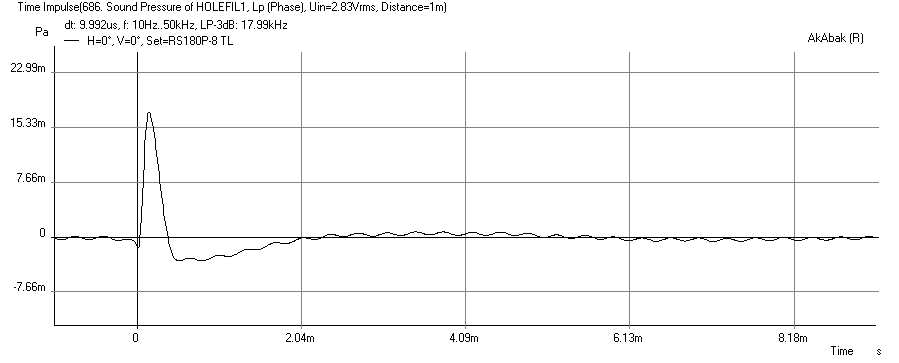
These are very rough sims in Akabak to show the hole filler concept. The model of the RS28F is approximate as I had to estimate the rear chamber and dome curvature etc. RS180P and B80 T/S params are from manufacturer specs. I guess I should use my own measured ones from DATS but this is something I whipped up on my commute to work this morning.
Here is response of drivers alone with a 1.9kHz XO point. Sims are showing baffle step losses greater than I anticipated - in 4pi space sensitivity is only 83dB. You can see how important the mid range hole filler driver is - it has to work over a very wide range to fill in what appears to be a very notch. Not too many drivers are capable of a linear wide bandwidth like this:

Here is what it looks like with no B80 mid showing the deep "hole" that forms when you have two second order filters in phase (both +ve absolute phase):

Now if we turn on the B80 (I still need to fine tune phase and maybe add a notch filter or two), you get this - the B&O Hole Filler XO:

Here is the impulse response:

Attachments
Last edited:
X's first experience with a real power tool
Most of you know me for foam core speaker builds and this is my first speaker with a real power tool (beyond a jig saw or hand drill). A friend loaned me a very powerful plunge router - he has 5 of them I used a circle cutting jig and a sacrificial backing board screwed in place. It all worked very well and the carbide blade cuts MDF like butter. An enormous amount of waste is generated and I am glad I did this outside. Anyhow, here are a few photos of what took me 2 hours to cut two, albeit, quite precise holes with flush mount rebates. This was a test baffle so I can make another but it turned out quite well.
I used a circle cutting jig and a sacrificial backing board screwed in place. It all worked very well and the carbide blade cuts MDF like butter. An enormous amount of waste is generated and I am glad I did this outside. Anyhow, here are a few photos of what took me 2 hours to cut two, albeit, quite precise holes with flush mount rebates. This was a test baffle so I can make another but it turned out quite well.
Layout work:
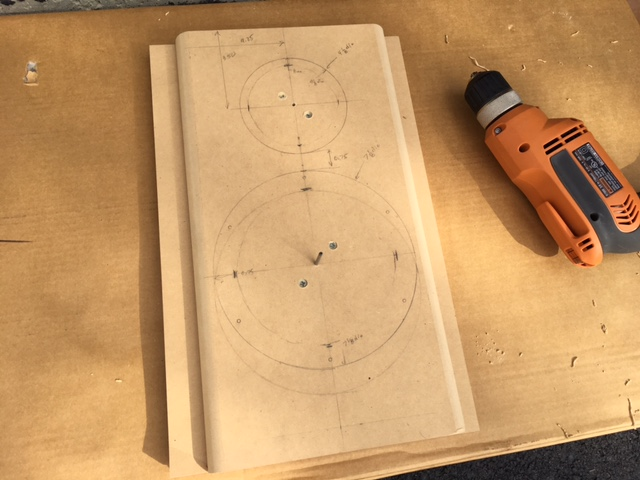
Initial cut, so far so good...:
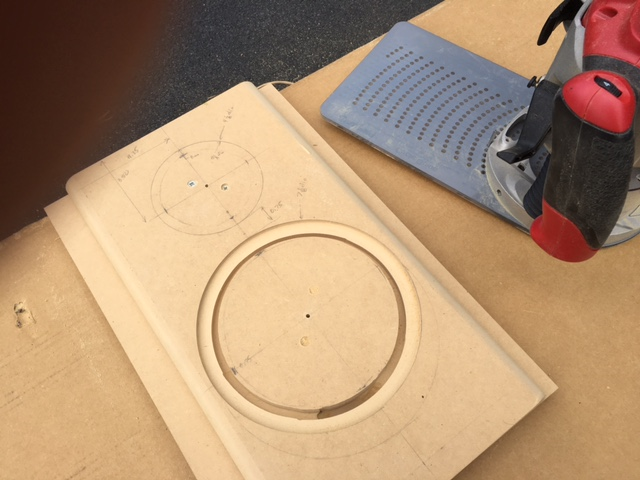
Finished:
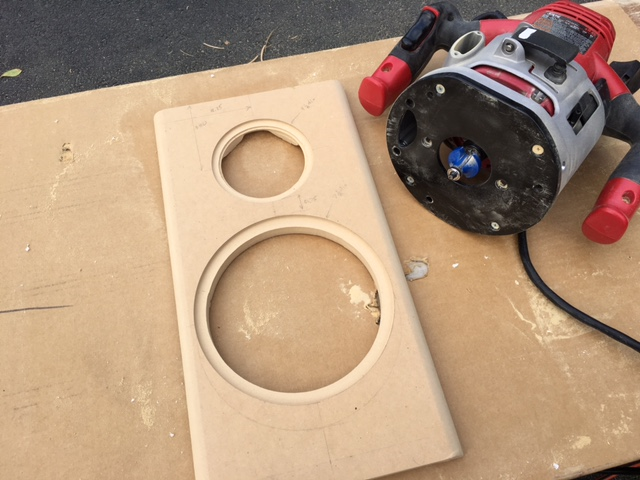
Backside round-over for good mid range air flow:
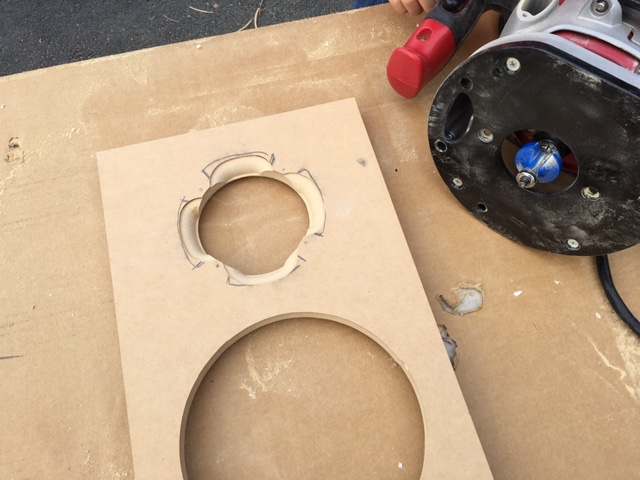
Most of you know me for foam core speaker builds and this is my first speaker with a real power tool (beyond a jig saw or hand drill). A friend loaned me a very powerful plunge router - he has 5 of them
Layout work:

Initial cut, so far so good...:

Finished:

Backside round-over for good mid range air flow:

Attachments
Last edited:
Nice work X!
You'll get the hang of it and do this in 1/4 of the time, you'll see. I did several builds and it gets easier and easier every time. I'm also finishing up the speakers in my signature this week. Should go to paint this weekend, finally!
Looking forward to see more of your project!
Ciao!
Do
You'll get the hang of it and do this in 1/4 of the time, you'll see. I did several builds and it gets easier and easier every time. I'm also finishing up the speakers in my signature this week. Should go to paint this weekend, finally!
Looking forward to see more of your project!
Ciao!
Do
Hi Do,
Thanks for the encouragement. Hopefully the second baffle will go faster. I am a little concerned about minimizing center-to-center distances - but there are practicalities like giving enough room for mounting the mid's rear chamber etc. I am estimating the setback of the tweeter is going to be around 2.5in from the baffle front (assuming a -25mm acoustic center on the woofer). The mid should be set back as well - or recessed in a 2in deep waveguide, but it's just not practical given the tight spacing.
I still have another baffle to play with if anyone has strong objections to how the baffle is going so far.
Thanks for the encouragement. Hopefully the second baffle will go faster. I am a little concerned about minimizing center-to-center distances - but there are practicalities like giving enough room for mounting the mid's rear chamber etc. I am estimating the setback of the tweeter is going to be around 2.5in from the baffle front (assuming a -25mm acoustic center on the woofer). The mid should be set back as well - or recessed in a 2in deep waveguide, but it's just not practical given the tight spacing.
I still have another baffle to play with if anyone has strong objections to how the baffle is going so far.
Looking good, I was kinda hoping you'd get back to speakers after all the amp stuff you've been doing. Good luck with the power tools
Ha ha - I have to admit that building amps can be addictive. It's a little like fishing or gambling, or speaker building for that matter. You chase the elusive big one that is out there hoping to land it with a tiny rod and lightweight test line.
The thing with amps is that it's a lot less expensive and can be made fairly quickly without a huge mess of sawdust. Now that I have about a dozen amps, most sound excellent, and could be used for a multiway active 4 way system even (8 amps). With a pure class A on the tweeter and nice class AB's on mids and woofers. I have about all I need now - but still need a good passive speaker to audition my amps.
I debated whether or not to get the aluminum RS28A or the silk RS28F. The aluminum one, made famous in Bagby's Contiunuum seems to have a rougher response curve. In the end I picked the silk in favor mainly because I wanted to keep the smoother tone of natural materials like paper cone vs metal cone. I think there is an error in the TS params for the RS28F though as it shows Le of 0.34mH. That value would make the driver falloff rather steeply in the highs. The RS28A by contrast has an Le of 0.04mH. Might be a decimal slip typo.
I should have gotten a router 100 years ago.
It's a slick tool for making very nice edges, that's for sure. The circle cutter jig really does a great job with a nice precise cutout complete with rebate for recessed mounting of a driver. For a tweeter, this can be huge as I have seen 5dB ripples result from a 3mm lip that is not flush mounted.
It was a bit intimidating to use at first but seems not so bad once you actually try it. Unfounded fears of "burning" the wood etc. I think it helps to have a nice high power one and quality carbide blades. The simple 1/4in straight blade seems unreasonably expensive at $20 - but when you think of the stresses it must see spinning at some crazy rpm and chewing away wood like butter, it's perfectly reasonable to charge that much.
Sealed RS180P
Here is what this speaker might look like as a sealed alignment (assuming 14L chamber), not much bass with F3 of 91Hz:
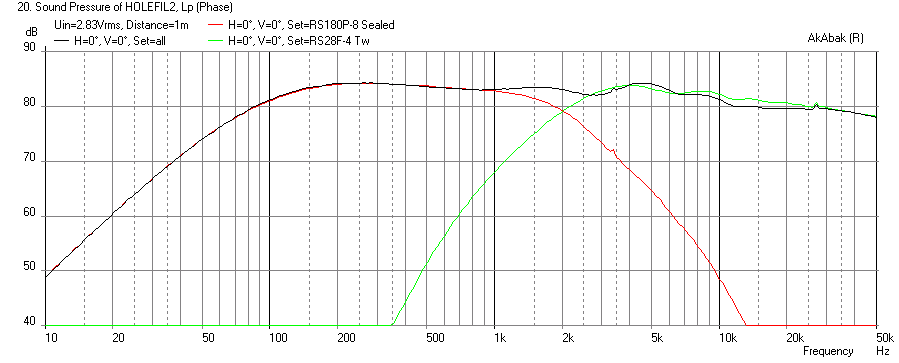
Although one can see how it really tightened up the impulse response into a narrow spike now:

This will translate to a much tighter transient response. Hmm...
Here is what this speaker might look like as a sealed alignment (assuming 14L chamber), not much bass with F3 of 91Hz:

Although one can see how it really tightened up the impulse response into a narrow spike now:

This will translate to a much tighter transient response. Hmm...
Attachments
I debated whether or not to get the aluminum RS28A or the silk RS28F. The aluminum one, made famous in Bagby's Contiunuum seems to have a rougher response curve. In the end I picked the silk in favor mainly because I wanted to keep the smoother tone of natural materials like paper cone vs metal cone. I think there is an error in the TS params for the RS28F though as it shows Le of 0.34mH. That value would make the driver falloff rather steeply in the highs. The RS28A by contrast has an Le of 0.04mH. Might be a decimal slip typo.
I suspect so (I haven't got access to my archive at the moment as I'm away from home, otherwise I'd confirm). The F's a nice tweeter and very flexible. That said, the RS28a actually measures better than its current data set implies, or at least, the last ones I fooled with did. It does have some drop above 15KHz, but they presumably accepted that as the price for running an aluminium dome without a Helmholtz on it. So the A can be a bit 'dull' off-axis. Different sort of sound & priorities. I like them both, for different reasons. I reckon you're going to be a happy camper when you fire them up.
To give a sense of scale of the speaker - here are the bass and mid drivers fitted to the baffle on the box. The tweeter (or mid) will go on an external trapezoidal baffle mount that will be set back about 3.5in from main front baffle (TBD with measurement of time alignment). I think I need to look at simulated verticalnpilats in Akabak to see which way I should mount the drivers: TMW or MTW?
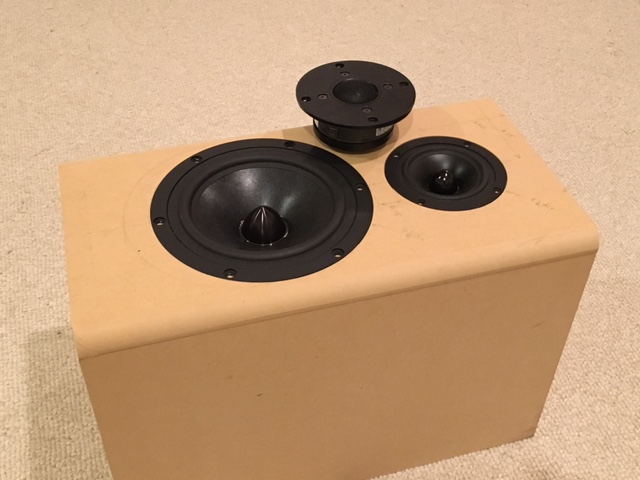

Attachments
I'm exploring the differences in the vertical polars for TMW vs MTW and surprisingly, it seems that the MTW has a smoother vertical polar response. This may pose a problem because to get time alignment on the tweeter will require setback via a waveguide, which at this point was not part of the plan. Although I could cut a new baffle with provision for the WG, it would increase CTC spacing between between the WT and TM.
Vertical polar for MTW:
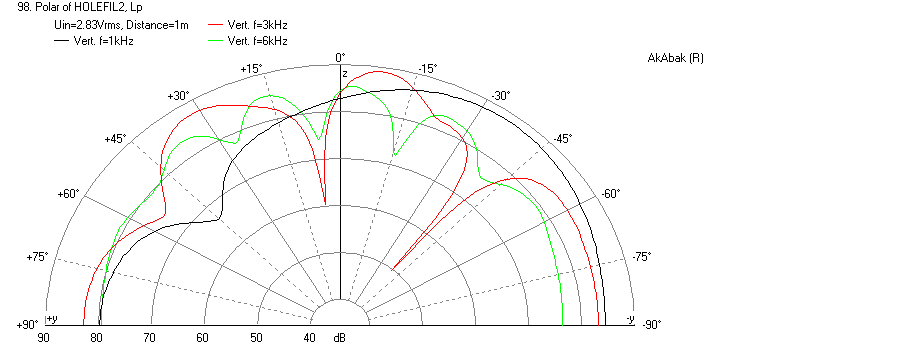
Vertical polar for TMW - this one would indicate one should flip the speaker upside down with WTM and place it a little below ear height for best performance:
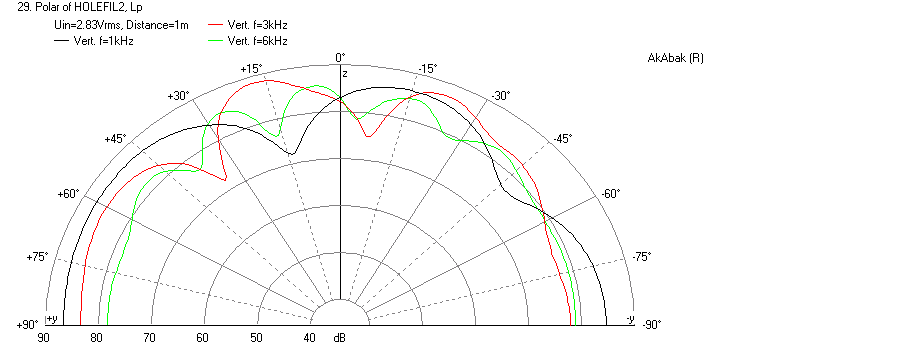
These polars are a reminder of why I like my point source Trynergy/Synergies etc...
Vertical polar for MTW:

Vertical polar for TMW - this one would indicate one should flip the speaker upside down with WTM and place it a little below ear height for best performance:

These polars are a reminder of why I like my point source Trynergy/Synergies etc...
Attachments
Last edited:
Still would like hear input from folks regarding the TMW vs MTW arrangement. So far it looks like MTW gives a smoother vertical polar according to my sims. Is this right because TMW speakers seem to be the norm in commercial offerings. Do I have this wrong?
If going MTW route I would need to redo baffle to accommodate a waveguide for the tweeer to allow sufficient setback for time alignment.
If going MTW route I would need to redo baffle to accommodate a waveguide for the tweeer to allow sufficient setback for time alignment.
- Status
- This old topic is closed. If you want to reopen this topic, contact a moderator using the "Report Post" button.
- Home
- Loudspeakers
- Multi-Way
- RS28F-RS180P-B80 as Hole Filler 3-way
